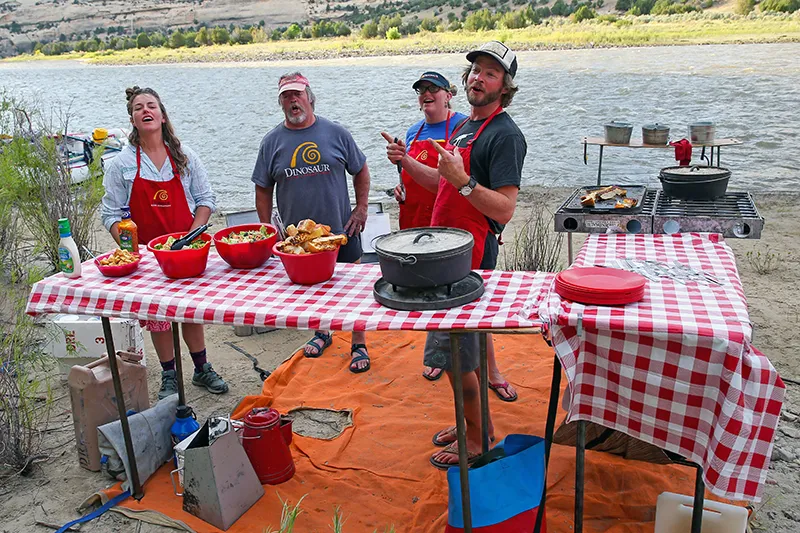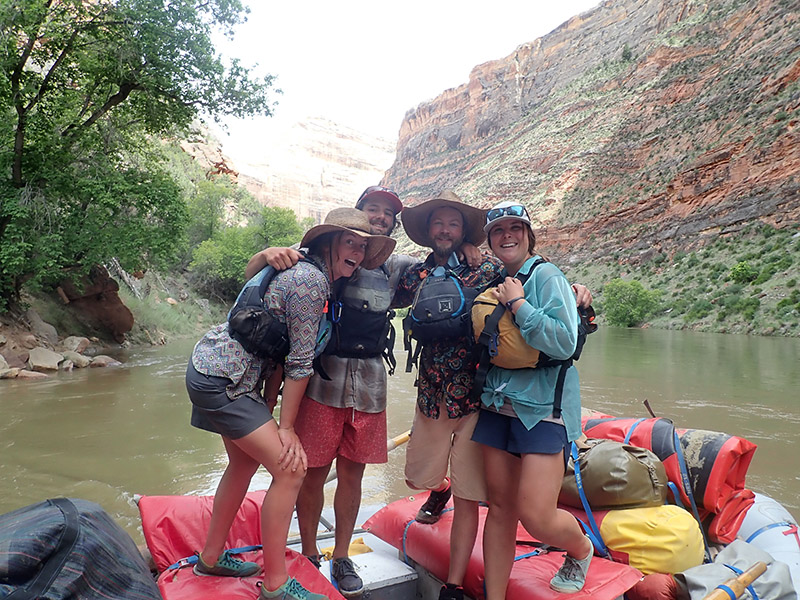There’s always a risk when you’re riding the rapids, making it essential to know basic safety measures before your rafting excursion. First-time rafters should always review safety information and come to their expedition prepared. Here are some tips on preparing for your first water rafting excursion.
10 Safety Tips For First-time Rafters
For first-time water rafters, it’s crucial to prioritize safety to ensure an enjoyable and risk-free experience. Here are some safety practices to bear in mind:
1. Choose a Reputable Rafting Company: Select a reputable and licensed rafting company with experienced guides who prioritize safety. Research their certifications, reviews, and safety record before booking.
2. Wear Appropriate Safety Gear: Wear a fully equipped personal flotation device (PFD) or life jacket supplied by the rafting business at all times. Ensure it is fastened securely and meets safety standards. Additionally, wear a helmet to protect your head from potential impact.
3. Listen to the Guide’s Instructions: Pay close attention to the safety briefing and instructions provided by the rafting guide before starting the trip. Understand the paddle commands, proper paddling technique, and how to respond to potential hazards.
4. Follow Proper Paddling Technique: Learn and use the correct paddling techniques taught by your guide. Coordinate with your team and follow their lead to maintain stability and maneuver the raft effectively.
5. Stay Inside the Raft: Always remain inside the raft and avoid standing or jumping out unless instructed by the guide. If you do fall out, follow the guide’s instructions for self-rescue or assistance from the rescue team.
6. Maintain a Secure Grip: Hold the raft’s handles or ropes securely to maintain stability and prevent accidental falls. Avoid placing your hands or feet near rocks or other potential hazards in the water.
7. Be Aware of River Hazards: Stay vigilant and watch for potential hazards in the river, such as rocks, branches, or strong currents. Listen to the guide’s warnings and follow their guidance to navigate safely.
8. Dress Appropriately: Wear proper attire suitable for rafting, including quick-drying clothing, secure footwear (water shoes or sandals with straps), and a hat for sun protection. Avoid loose clothing that may get tangled or restrict movement.
9. Stay Hydrated and Protected: Bring along sunscreen, sunglasses, and a water bottle to stay hydrated and protected from the sun’s rays. Apply sunscreen before the trip and reapply as needed.
10. Communicate and Stay Calm: Maintain open communication with your rafting team and the guide. If you have concerns or questions, don’t hesitate to speak up. Stay calm and follow instructions during challenging situations to ensure everyone’s safety.
Remember, water rafting involves inherent risks, but by following these safety practices, you can minimize the chances of accidents and enjoy a thrilling yet safe adventure on the river.
5 Ways to Stay Safe While Rafting
First-time water rafters should prioritize safety by following these key practices:
1. Wear appropriate safety gear: Always wear a properly fitting life jacket and helmet. These items can help protect you from injury and keep you afloat in case you fall out of the raft.
2. Listen to your guide: Your guide is there to keep you safe and provide instructions. Pay attention to their guidance and follow their directions carefully.
3. Stay in the raft: It may be tempting to jump out and swim, but it’s important to stay in the raft at all times. Falling out of the raft can be dangerous, especially in fast-moving water.
4. Keep your feet up: If you do fall out of the raft, keep your feet up and pointed downstream. This can help you avoid hitting rocks or other obstacles in the water.
5. Be aware of your surroundings: Keep an eye out for potential hazards, such as rocks, rapids, or other obstacles. Stay alert and be prepared to react quickly if necessary.
By following these safety practices, first-time water rafters can enjoy a fun and exciting experience while minimizing the risk of injury or accidents.
Be Aware of the Weather, Drink Plenty of Water and Dress Appropriately
Water rafting is a thrilling sport that promises unforgettable moments. The surge of adrenaline, the thunder of the rapids, and the pure delight of mastering nature’s powers are all part of the experience. But following water rafting safety procedures is essential if you want to maximize your fun and guarantee everyone’s safety.
Drink plenty of water and use sunscreen
During rafting excursions, especially in hot weather, proper hydration is essential. To prevent dehydration, drink a lot of water both before and during the expedition. Apply a waterproof sunscreen with a high SPF as well to shield your skin from the damaging UV radiation that the water reflects.
Be Aware of the Weather
Weather poses unique challenges to rafting. The strong river flow that results from heavy rain or swiftly melting snow may significantly alter the difficulty and character of a river. The barriers will be many since the rapids will be more intense, the water will move more quickly, and debris may have been carried into it.
On the other hand, if there has been a dry spell and the water levels are low, this can also lead to issues with previously hidden rocks and dangers. Rafting in cold weather requires extra caution when it comes to safety. If the water is excessively cold, specialized equipment, such as drysuits or full-body wetsuits, is sometimes required. The water may be mountain runoff from snowmelt in the early spring. The water will be chilly no matter how far downriver you are. Being immersed in frigid water causes hypothermia to set in extremely quickly. So keep an eye on the weather forecast and the source of your water to remain safe.
Make sure you are dressed appropriately for the day outside
The water could be a touch cool in the early spring. The journey may be made much more comfortable by using a wet suit, splash jacket, and appropriate river shoes, which will allow you to experience the excitement without the chill. Some outfitters provide equipment rental. A reliable outfitter will have the necessary equipment.
Find out if the outfitter has your gear before you make a reservation. On the opposite end of the spectrum, be ready for bright, sunny days. Wearing quick-drying garments like polypro, applying sunscreen, and donning an inexpensive pair of sunglasses with UV protection may help you do this.
Learn From an Expert and Stay Aware
Water rafting is an exhilarating experience that draws thrill-seekers from all over the world because of its heart-pounding rapids and gorgeous landscapes. To provide a pleasurable and secure experience on the water, safety must be prioritized despite the excitement.
Pay attention to the safety briefing
Pay close attention to the rafting guides’ safety instructions. They will offer crucial details on safe paddling practices, emergency procedures, and any potential risks in the area. To guarantee a coordinated and safe trip on the water, carefully comprehend and adhere to their directions.
Be Aware of the River You Will Be Rafting
Each river has distinct risks and hazards that rafters must avoid. To make sure your journey is successful, it is essential to learn about each hazardous segment or location. To identify any and all potential barriers, read reference books, internet resources, river maps, and locals.
If you are unclear on how to properly negotiate the rapid, it’s also a good idea to scope out the following portions on foot. Finally, be aware of your group’s past experiences, and don’t undervalue the river. You must be aware of your group’s limitations and match them to the level of difficulty of the rapids you anticipate encountering.
Properly hold the paddle
Proper paddle holding can pose serious safety risks. At the bottom of the paddle’s shaft, place one hand. Always position the other hand over the “T” grip on the end of the shaft. Hard plastic “T” grips can cause teeth to fall out and blacken eyes. Keeping your hand on the “T” grip will allow you to maintain control of the paddle and soften any potential blows. Ask your qualified commercial guide for the correct method.
Ben Gold
Have the Proper Gear and Skills
To ensure a safe and enjoyable rafting experience, it is crucial for first-timers to be well-prepared and informed. One of the most important safety practices is to wear appropriate personal protective equipment, including a well-fitted life jacket and a helmet. These items can provide vital protection in the event of an accidental fall or collision. Additionally, it is essential to listen attentively to the instructions provided by the professional rafting guides and to follow their guidance throughout the trip.
Another crucial aspect of water rafting safety is understanding the importance of proper swimming skills. While no one expects first-timers to be expert swimmers, having basic swimming abilities can significantly enhance personal safety and confidence in the water. Additionally, maintaining a good level of physical fitness and staying hydrated during the rafting excursion are important factors to consider.
In conclusion, water rafting can be an exhilarating and memorable experience for first-timers, but it is vital to prioritize safety. By adhering to essential safety practices, wearing the right gear, following the instructions of professional guides, and possessing basic swimming skills, first-timers can embark on a thrilling rafting adventure while minimizing potential risks.
This is a crowdsourced article. Contributors’ statements do not necessarily reflect the opinion of this website, other people, businesses, or other contributors.






